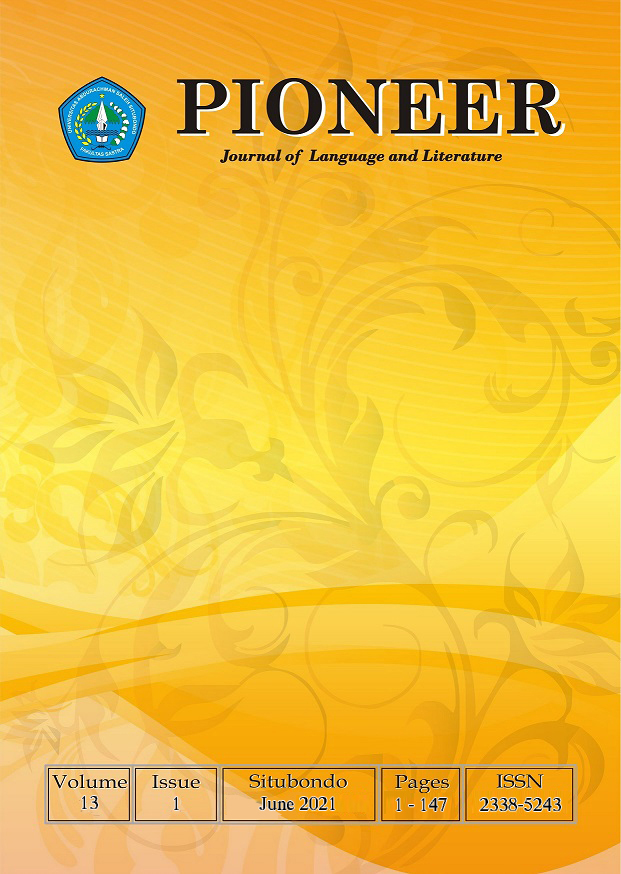Strengths and Weaknesses of Collaborative Writing and Peer Feedback in an EFL Intensive Reading and Writing Coursework
Abstract
The advantages of collaborative writing and peer feedback have contributed to give significant effect to the writing ability of L1 (first language) learners, L2 (second language) learners, and FL (foreign language) learners. The objective of this study was to find out the strengths and weaknesses of collaborative writing and peer feedback in an EFL intensive reading and writing coursework classroom especially in English education department students of Hasyim Asy’ari University. This study used a qualitative method where the data were described qualitatively. As this study used a qualitative approach, therefore observation and interview were used as instruments to collect the data. The result showed that collaborative writing and peer feedback strategies were not easy to be implemented in an EFL classroom. There were some strengths and weaknesses found during the observation. The strengths of these strategies showed that students could share ideas, improve grammar and vocabulary, make students more active, have good cooperation among peers, build self-confidence and make students happy. However, the strategies may not give any significant effect on the students’ cognitive ability in writing skills if most of the students have the low ability in mastering English. In addition, a smart student would prefer to write individually than in collaborative writing.
Downloads
References
Ariyanti. (2016). The Teaching of EFL Writing in Indonesia. Dinamika Ilmu, 16(2), 263. https://doi.org/10.21093/di.v16i2.274
Chen, W., & Yu, S. (2019). A longitudinal case study of changes in students’ attitudes, participation, and learning in collaborative writing. System, 82, 83–96. https://doi.org/10.1016/j.system.2019.03.005
Duff, D., Tomblin, J. B., & Catss, H. (2015). The Influence of Reading on Vocabulary Growth: A Case for a Matthew Effect. Journal of Speech, Language, and Hearing Research, 58(3), 853–864. https://doi.org/10.1044/2015
Hande, S. (2014). Strengths weaknesses opportunities and threats of blended learning: Students′ perceptions. Annals of Medical and Health Sciences Research, 4(3), 336. https://doi.org/10.4103/2141-9248.133455
Hanifah, Z. (2018). Strengths and Weaknesses to Teach EFL Students and Its Relation to Students ’ Self-esteem in Writing. In 2 nd English Language and Literature International Conference (ELLiC) (Vol. 2, pp. 59–64).
Harutyunyan, L., & Poveda, M. F. (2011). Students’ Perception of Peer Review in an EFL Classroom. English Language Teaching, 11(4), 138. https://doi.org/10.5539/elt.v11n4p138
Herwiana, S. (2021). Strategy to Teach Writing in a Big Class. Jombang, Jawa Timur: LPPM UNHASY Tebuireng Jombang.
Hidayati, D. (2018a). Extensive and intensive reading in an EAP setting. English for Specific Purposes, 16(1), 47–60. https://doi.org/10.1016/S0889-4906(96)00031-2
Hidayati, D. (2018b). Students Difficulties in Reading Comprehension At. Students Difficulties in Reading Comprehension At.
Huett, A., & Koch, R. T. (2011). COLLABORATIVE WRITING STRATEGIES.
Latief, M. A. (2013). Research Methods on Language Learning an Introduction (2nd Ed.). Malang: UM Press.
Lin, G. H. C., & Chien, P. S. C. (2009). An Investigation into Effectiveness of Peer Feedback. Journal of Applied Foreign Languages Fortune Institute of Technology, 3(1983), 79–87.
McDonough, K., De Vleeschauwer, J., & Crawford, W. (2018). Comparing the quality of collaborative writing, collaborative prewriting, and individual texts in a Thai EFL context. System, 74, 109–120. https://doi.org/10.1016/j.system.2018.02.010
Murtiningsih, S. (2016). Collaborative Writing in an EFL Context. Journal of Foreign Language Teaching and Learning, 1(1), 82–90. https://doi.org/10.18196/ftl.118
Nelson, S. (2000). Teaching Collaborative Writing and Peer Review Techniques to Engineering and Technology Undergraduates. In Proceedings-Frontiers in Education Conference, 30th Annual. Kansas, MO, USA. https://doi.org/10.1109/FIE.2000.896636
Ng, Q. R., Renandya, W. A., & Chong, M. Y. C. (2019). Extensive reading: Theory, research and implementation. Teflin Journal, 30(2), 171–186. https://doi.org/10.15639/teflinjournal.v30i2/171-186
Sukirman. (2016). Using collaborative writing in teaching writing. LANGKAWI, 2(1), 33–46. https://doi.org/http://dx.doi.org/10.31332/lkw.v2i1.443
Veramuthu, P., & Shah, P. M. (2020). Effectiveness of Collaborative Writing among Secondary School Students in an ESL Classroom. Creative Education, 11(01), 54–67. https://doi.org/10.4236/ce.2020.111004
Yastıbaş, G. Ç., & Yastıbaş, A. E. (2015). The Effect of Peer Feedback on Writing Anxiety in Turkish EFL (English as a Foreign Language) Students. Procedia - Social and Behavioral Sciences, 199, 530–538. https://doi.org/10.1016/j.sbspro.2015.07.543
An author who publishes in Pioneer: Journal of Language and Literature agrees to the following terms:
- Author retains the copyright and grants the journal the right of first publication of the work simultaneously licensed under the Creative Commons Attribution-ShareAlike 4.0 License that allows others to share the work with an acknowledgement of the work's authorship and initial publication in this journal
- Author is able to enter into separate, additional contractual arrangements for the non-exclusive distribution of the journal's published version of the work (e.g., post it to an institutional repository or publish it in a book) with the acknowledgement of its initial publication in this journal.
- Author is permitted and encouraged to post his/her work online (e.g., in institutional repositories or on their website) prior to and during the submission process, as it can lead to productive exchanges, as well as earlier and greater citation of the published work (See The Effect of Open Access).

























